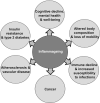Nutrition, Immunosenescence, and Infectious Disease: An Overview of the Scientific Evidence on Micronutrients and on Modulation of the Gut Microbiota
- PMID: 36183242
- PMCID: PMC9526826
- DOI: 10.1093/advances/nmac052
Nutrition, Immunosenescence, and Infectious Disease: An Overview of the Scientific Evidence on Micronutrients and on Modulation of the Gut Microbiota
Abstract
The immune system is key to host defense against pathogenic organisms. Aging is associated with changes in the immune system, with a decline in protective components (immunosenescence), increasing susceptibility to infectious disease, and a chronic elevation in low-grade inflammation (inflammaging), increasing the risk of multiple noncommunicable diseases. Nutrition is a determinant of immune cell function and of the gut microbiota. In turn, the gut microbiota shapes and controls the immune and inflammatory responses. Many older people show changes in the gut microbiota. Age-related changes in immune competence, low-grade inflammation, and gut dysbiosis may be interlinked and may relate, at least in part, to age-related changes in nutrition. A number of micronutrients (vitamins C, D, and E and zinc and selenium) play roles in supporting the function of many immune cell types. Some trials report that providing these micronutrients as individual supplements can reverse immune deficits in older people and/or in those with insufficient intakes. There is inconsistent evidence that this will reduce the risk or severity of infections including respiratory infections. Probiotic, prebiotic, or synbiotic strategies that modulate the gut microbiota, especially by promoting the colonization of lactobacilli and bifidobacteria, have been demonstrated to modulate some immune and inflammatory biomarkers in older people and, in some cases, to reduce the risk and severity of gastrointestinal and respiratory infections, although, again, the evidence is inconsistent. Further research with well-designed and well-powered trials in at-risk older populations is required to be more certain about the role of micronutrients and of strategies that modify the gut microbiota-host relationship in protecting against infection, especially respiratory infection.
Keywords: aging; gut microbiota; immunity; infection; inflammation; selenium; vitamin C; vitamin D; vitamin E; zinc.
© The Author(s) 2022. Published by Oxford University Press on behalf of the American Society for Nutrition.
Figures




References
-
- Calder PC, Kew S. The immune system: a target for functional foods?. Br J Nutr. 2002;88:S165–76. - PubMed
-
- Cummings JH, Antoine J-M, Aspiroz F, Bourdet-Sicard R, Brandtzaeg P, Calder PCet al. PASSCLAIM—gut health and immunity. Eur J Nutr. 2004;43(Suppl 2):118–73. - PubMed
-
- Albers R, Antoine J-M, Bourdet-Sicard R, Calder PC, Gleeson M, Lesourd Bet al. Markers to measure immunomodulation in human nutrition intervention studies. Br J Nutr. 2005;94:452–81. - PubMed

